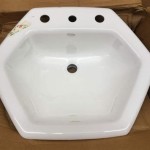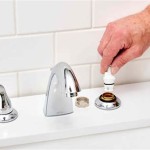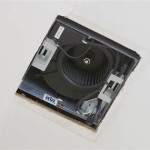Small Floating Bathroom Sinks
Small floating bathroom sinks offer a sleek, modern solution for maximizing space in compact bathrooms or powder rooms. Their wall-mounted design eliminates the need for a traditional vanity, freeing up valuable floor space and creating a visually lighter, more open feel. This article explores the benefits, considerations, and options associated with incorporating a small floating bathroom sink into a bathroom design.
Space Optimization
The most significant advantage of a small floating sink is its space-saving capability. By eliminating the bulk of a vanity cabinet, these sinks open up floor space, making even the smallest bathroom feel larger. This can be particularly beneficial in urban apartments, tiny homes, or guest bathrooms where every square inch counts. The open space beneath the sink also simplifies cleaning and allows for storage of small items like a wastebasket or a set of scales.
Style and Aesthetics
Floating sinks contribute to a clean, contemporary aesthetic. They offer a minimalist profile that complements modern bathroom designs. Available in a variety of materials, shapes, and sizes, these sinks can be tailored to suit individual preferences and the overall bathroom style. From sleek rectangular basins to rounded bowls, there's a floating sink to match any design vision. The exposed plumbing, often incorporated into modern designs, further enhances the minimalist appeal.
Installation and Considerations
While floating sinks offer numerous benefits, proper installation is crucial. The wall must be strong enough to support the weight of the sink and its contents. This usually requires reinforced framing, especially in older homes. Careful planning is essential to ensure the sink is positioned at a comfortable height and with adequate clearance for plumbing connections. It's recommended to consult a qualified plumber for installation to ensure structural integrity and proper functionality. Additionally, the lack of vanity storage necessitates alternative storage solutions in the bathroom.
Material Selection
Small floating sinks are available in a variety of materials, each with its own advantages and aesthetic qualities. Porcelain is a classic choice, offering durability, affordability, and ease of cleaning. Vitreous china is a higher-grade porcelain with a denser, more durable finish. Glass sinks provide a sleek, modern look, while concrete and stone offer a more natural, textured appeal. Choosing the right material depends on budget, style preferences, and the overall bathroom design.
Size and Shape
Small floating sinks come in a range of sizes and shapes to suit different bathroom layouts and needs. Compact rectangular sinks are ideal for narrow spaces, while round or oval sinks can soften the lines of a bathroom. Corner sinks are an excellent solution for maximizing space in tight corners. Careful consideration of the available space and the intended use will help determine the most appropriate size and shape for the sink.
Plumbing and Fixtures
The plumbing for a floating sink can be exposed or concealed, depending on the desired aesthetic. Exposed plumbing, often featuring chrome or brushed nickel pipes, can add a stylish industrial touch. Concealed plumbing, on the other hand, provides a cleaner, more minimalist look. Choosing the right faucet is also important. Wall-mounted faucets complement the floating design and save counter space. Single-lever faucets offer convenient temperature and flow control. The choice of fixtures should complement the overall style of the bathroom.
Maintenance and Cleaning
Maintaining a small floating sink is generally straightforward. Regular cleaning with a mild detergent and a soft cloth is usually sufficient to keep the sink looking its best. Avoid abrasive cleaners, which can scratch the surface of the sink. Regularly check the plumbing for leaks and address any issues promptly to prevent damage to the wall or surrounding areas. The open space beneath the sink makes cleaning the floor easier than with a traditional vanity.
Accessibility Considerations
When choosing a small floating sink, consider accessibility requirements. The height of the sink should be appropriate for users of varying heights and abilities. Wall-mounted grab bars can be installed near the sink to provide additional support. It’s crucial to comply with local building codes and accessibility guidelines when installing a floating sink in a bathroom intended for use by individuals with mobility challenges.
Ultimately, the decision to install a small floating bathroom sink depends on individual needs, preferences, and the specific characteristics of the bathroom space. By carefully considering the factors outlined above, homeowners can make informed choices that enhance both the functionality and aesthetics of their bathrooms.

Floating Vanity Cabinetry Read Description Carefullyraw Bathroom Vanities Interior Decor

Floating Shelf Vanity Small Bathroom Sinks Sink

Scarabeo 5115 By Nameek S Teorema 2 Rectangular Ceramic Wall Mounted Or Vessel Sink With Counter Space Thebath

24 White Wall Mount Modern Small Floating Bathroom Sink

Domani Millhaven 30 In W X 19 D 22 H Single Sink Floating Bath Vanity Caramel Mist With White Cultured Marble Top B30x20241 The Home Depot

24 Floating Bathroom Vanity Ideas Sleek Funtional

Floating Bath Vanities Pottery Barn

Nameeks Derin139 By Nameek S Derin Modern Bathroom Vanity With Beige Travertine Design Sink Small Floating 24 Brown Oak Thebath

12 Open Shelf Bathroom Vanities That Are Both Chic And Practical Hunker Floating Vanity Small

Rustic Modern Bathroom Vanity In Small Powder Room Floating Ideas
Related Posts







